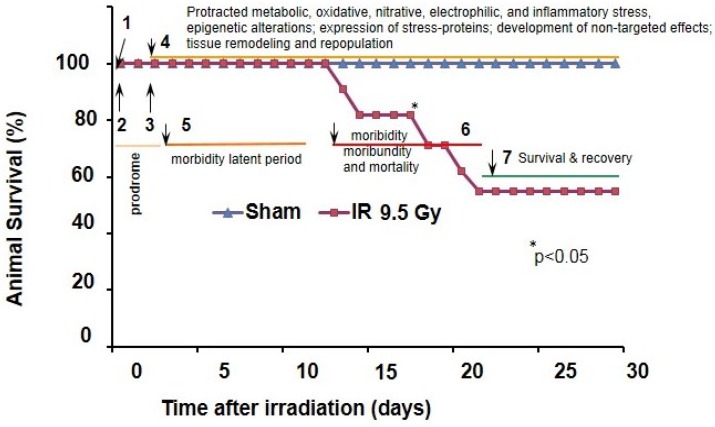Figure 1.
Kaplan–Meier survival plot and post-irradiation (post-IR) events in mouse model of the hematopoietic acute radiation syndrome (hARS). 1—Radiolysis due to pulse-irradiation and associated formation of (i) electrophilic and nucleophilic species; (ii) reactive oxygen and nitrogen species (ROS and RNS); (iii) electrophil-derived danger-associated molecular patterns (DAMPs), pro-inflammatory oxysterols, and clastogenic plasma factors in the target-cells and fluids. Time-lag is minutes; 2—Induction of cell and organ system responses to the targeted and non-targeted effects including redox-stress due to disruption of mitochondrial redox circuitry in the photon-targeted mitochondria; electrophilic stress; epigenetic changes. Time-lag is hours; 3—Direct cytocidal response (time lag is from hours through two to three days, end of prodrome); Development of clonogenic suppression, acute phase response, non-septic inflammation, lymphopenia, neutropenia, immunosuppression (time lag is days); 4—Protracted oxidative, nitrative, electrophilic and proteotoxic stress; development of clastogenic, metabolic and epigenetic responses; tissue remodeling and repopulation. Time lag for the reactive response is days; 5—Morbidity latent period: regressive hematological changes, development of coagulopathy and anemia, impairment of tissue barriers. Time-lag is 1–1.5 week; 6—Enteric bacteria breach the gut barriers; development of bacteremia, interstitial hemorrhage, moribundity and mortality (time-lag is 1–1.5 week); 7—Recovery during post-survival period (time-lag is days). The survival plot is adapted with modifications from: Kiang et al., 2014 [23]. Experimental conditions: hARS was induced by exposure of B6D2F1/J mice to 9.5 Gy whole-body bilateral 60Co gamma-photon radiation, delivered at a dose rate of 0.4 Gy/min (LD50/30).

